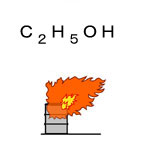| Case Name |
Fire of ethanol caused due to air intake in the ejector of a treatment drum at a surfactant manufacturing plant |
| Pictograph |

|
| Date |
March 24, 1998 |
| Place |
Kawasaki, Kanagawa, Japan |
| Location |
Chemical factory |
| Overview |
On March 24th, 1998. A fire occurred at the reactor of a surfactant manufacturing plant. A blockage happened at the chute of the funnel when an absorptive treatment chemical was being charged from the manhole of the reactor. The vacuum line was opened to make it easy to drop the chemical. Then, atmospheric air entered the reactor, in which air was replaced by nitrogen. Evaporated ethanol in the reactor mixed with air to generate a combustible gas-air mixture. Fire occurred due to static electric sparks. It was a problem that operators did not recognize an inlet air flow makes conditions inside the reactor dangerous. |
| Incident |
A fire occurred at a manufacturing plant for surfactant used in cosmetics. Some combustibles were charged and reacted in a reactor R-13. Then, an absorptive treatment chemical of magnesium aluminum oxide was charged through a metal funnel at the top of the manhole. The ejector was operated by remote control from a control room because feeding was not going well, and the chemicals in the R-13 chamber were sucked. A few seconds later, flames about 20 cm high occurred and one operator received burns. Refer to Fig2. |
| Processing |
Manufacture |
| Individual Process |
Feed and charge |
| Substance |
Ethanol, Fig3 |
| Type of Accident |
Fire |
| Sequence |
On March 24th, 1998, 14:35.
An operator charged absorptive treatment chemicals in a bag using a funnel from the manhole to the reactor. Only half of the bag (10 kg) entered the reactor.
14:40. Another operator in the control room operated the valve of a vacuum line to suck the chemicals and charge all of them into the reactor.
14:50. The valve opened, and the entire quantity (20 kg) was fed in. Flames occurred, and the field operator was injured.
14:50. The fire was extinguished. In the control room, the control operator closed the valve.
14:54. A rescuer of the private fire brigade gave first aid to the injured operator. The accident was reported to the fire fighting organization.
15:02. The injured operator was taken away and investigation was started by the public fire brigade. |
| Cause |
Atmospheric air flowed into a reactor which had been filled with nitrogen through a gap between the manhole and the funnel when the pressure in the reactor was reduced. Therefore, evaporated ethanol in the reactor mixed with the air, and a combustible gas-air mixture was generated. A fire broke out by static electric sparks. |
| Response |
A loud explosion was heard at the control room, and the valve of the vacuum line was closed. |
| Countermeasures |
1. Adsorbent must not be fed while the manhole is open.
2. Adsorbent must not be charged as powder but in a water slurry state.
3. Temperature of adsorbent during charging should be lowered from 50 °C to 40 °C or less, and the generation of solvent vapor should be suppressed. |
| Knowledge Comment |
It is a problem to have opened the vacuum line with the manhole opened, although a flow of air into the treatment drum causes dangerous conditions where a combustible gas-air mixture is generated. Improved safety management and education is needed. |
| Background |
The reactor was sealed from the outside air with nitrogen. However, operators allowed air to enter the reactor. Management of operation might have been insufficient. In other words, safety consciousness or knowledge seemed to be lacking. |
| Incidental Discussion |
The necessity to use slurry and maintain a closed system was understood after the accident. Such safety countermeasures should have been known before the accident. |
| Reason for Adding to DB |
Example of fire caused due to static electricity on feeding powder |
| Scenario |
| Primary Scenario
|
Organizational Problems, Poor Management, Poor Operation Management, Poor Value Perception, Poor Safety Awareness, Inadequate Risk Recognition, Ignorance, Insufficient Knowledge, Convincement, Planning and Design, Poor Planning, Poor Design, Malicious Act, Rule Violation, Safety Rule Violation, Secondary Damage, External Damage, Fire, Bodily Harm, Injury, 1 person burnt
|
|
| Sources |
Fire and Disaster Management Agency. Major examples of accidents. Accident cases of the dangerous materials. pp.24, 62-64.
Kawasaki City Fire fighting station. Prevention division. Fumio Itakura. Cases of fire caused by static electricity. Dangerous object accident case seminar. pp.21-36(1999).
|
| Number of Injuries |
1 |
| Physical Damage |
Heat insulation of piping at the upper part of R-13 was damaged by fire. The funnel was damaged. |
| Multimedia Files |
Fig2.Treatment drum figure
|
|
Fig3.Chemical formula
|
| Field |
Chemicals and Plants
|
| Author |
DOBASHI, Ritsu (School of Engineering, The University of Tokyo)
TAMURA, Masamitsu (Center for Risk Management and Safety Sciences, Yokohama National University)
|